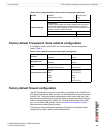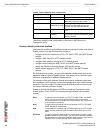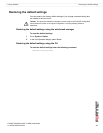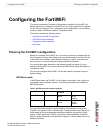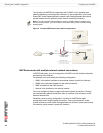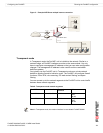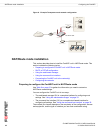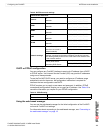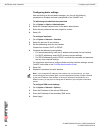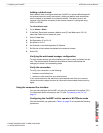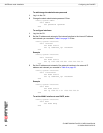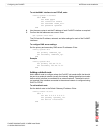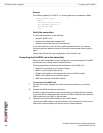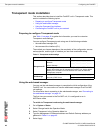
Configuring the FortiWiFi NAT/Route mode installation
FortiWiFi-60A/AM FortiOS 3.0 MR4 Install Guide
01-30004-0283-20070215 33
Table 9: NAT/Route mode settings
DHCP or PPPoE configuration
You can configure any FortiWiFi interface to acquire its IP address from a DHCP
or PPPoE server. Your Internet Service Provider (ISP) may provide IP addresses
using one of these protocols.
To use the FortiWiFi DHCP server, you need to configure an IP address range
and default route for the server. No configuration information is required for
interfaces that are configured to use DHCP.
PPPoE requires you to supply a user name and password. In addition, PPPoE
unnumbered configurations require you to supply an IP address. Use Table 10 to
record the information you require for your PPPoE configuration.
Table 10: PPPoE setting
Using the web-based manager
You can use the web-based manager for the initial configuration of the FortiWiFi
unit and all FortiWiFi unit settings.
For information about connecting to the web-based manager, see “Connecting to
the web-based manager” on page 18.
Administrator Password:
Internal
IP: _____._____._____._____
Netmask: _____._____._____._____
WAN1
IP: _____._____._____._____
Netmask: _____._____._____._____
WAN2
IP: _____._____._____._____
Netmask: _____._____._____._____
DMZ
IP: _____._____._____._____
Netmask: _____._____._____._____
WLAN
IP: _____._____._____._____
Netmask: _____._____._____._____
Network settings
Default Gateway: _____._____._____._____
(Interface connected to
external network)
A default route consists of a default gateway and the name of the
interface connected to the external network (usually the Internet).
The default gateway directs all non-local traffic to this interface and
to the external network.
Primary DNS Server: _____._____._____._____
Secondary DNS Server: _____._____._____._____
User name:
Password:



